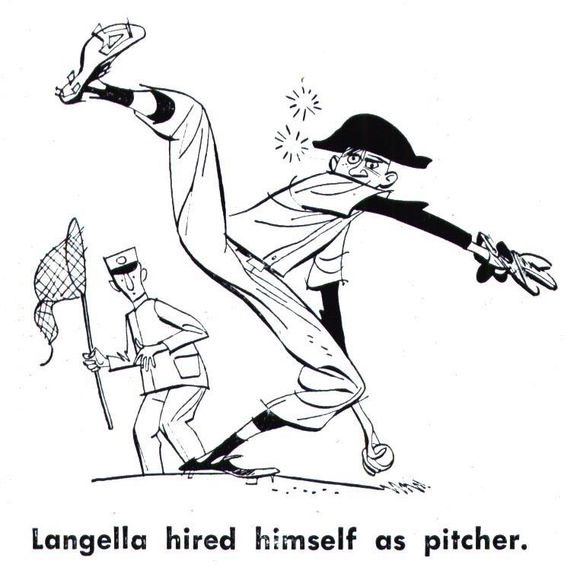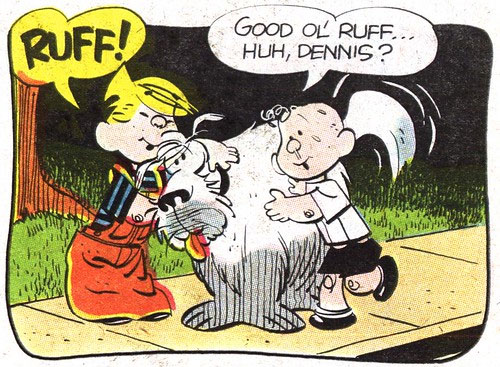'Sgt. Bilko' advertising strip for Camel cigarettes (late 1950s).
Bob Bugg was an American magazine illustrator and cartoonist, who worked for Collier's, Cosmopolitan and several sports magazines. His commercial artwork included a series of notable advertising comics for cigarette brands Camel and Winston, and several cover illustrations for trade paperbacks. Later in his career, he drew the single-panel cartoon series 'The New Neighbors' (1974-1976) and worked for Hank Ketcham on the 'Dennis the Menace' Sunday comic (1972-1982).
Early life
Robert Bruce Bugg was born in 1920 into a suburban community in Summit, New Jersey, and grew up in Larchmont, New York. His father was a New York City advertising executive who regularly treated his son to skiing trips. At age 14, Bob Bugg skied the first U.S. rope tow at Woodstock, Vermont, shortly after the opening in 1934. Besides being an avid sportsman, Bugg showed a talent for drawing. Already at the age of six, he decided to become a cartoonist, and spent his childhood years making posters and other artwork for his grade school.
'Martan the Marvel Man' (Popular Comics #56).
Early career
Fresh out of high school, Bugg sold his first gag cartoons to Collier's magazine. He got his artistic training during two years at the Art Students League, and was then part of the emerging comic book industry. His story artwork appeared in several comic books during the 1939-1942 period, drawing adventure features like 'Bob and Bill', 'Clyde Beatty', 'Dr. Hormone' and 'Martan the Marvel Man' for Dell Comics. He additionally drew for the Centaur Comics Group ('Fantom of the Fair'), Fiction House Comics ('Rocky Hall') and Hawley Publications ('Adventures of Bill Baker'). Bugg then spent four years in the U.S. Army, before returning to civilian life in 1946. Back in New York City, he embarked upon a freelance career in illustration, working mainly for magazines. By 1955, Bob and his wife Pat settled in New Canaan, Connecticut, at the time a rural retreat for New York City's executive class.
Illustrator
Robert Bugg made both serious and cartoony illustrations, but he preferred to call himself a "humorous illustrator", according to a 4 April 1965 article in The Bridgeport Post of Bridgeport, Connecticut. Bugg contributed to Collier's magazine until its demise in 1957, and also delivered slick, expressive artwork to Cosmopolitan, Argosy, This Week, Women's Day, Family Circle and many sports magazines. Still a passionate skier, Bugg made many spot cartoons, illustrations and cover drawings for Ski magazine from November 1959 on. His Ski assignments brought him to slopes in Colorado, Austria, Switzerland and France for inspiration. In 1954, he started illustrating the columns of E. V. Durling for the Sunday Pictorial Review, a weekly newspaper section produced by King Features Syndicate.
Advertising strip for Winston cigarettes, spoofing the movie 'Casablanca'.
With most of his magazine assignments drying out in the late 1950s, Bugg had to find other markets, such as commercial art. He notably made a series of late 1950s advertising comics for Camel cigarettes, starring Sergeant Bilko, a character performed by Phil Silvers on the TV sitcom 'You'll Never Get Rich' (AKA 'The Phil Silvers Show'). Another series aimed directly at soldiers for camp newspapers, but didn't star the Camel-smoking sergeant. Bugg also made a comic ad series for Winston cigarettes, spoofing movie genres. From 1963 on, Bugg turned to illustrating paperback covers. As an allround author, he released 'My Family and I' (Grosset & Dunlap, 1965), a cartoon satire on suburban life through the eyes of a quick-witted New Canaan girl called Melissa Thorndyke. Bugg adjusted his writing and drawing style, to make it seem the entire book was written and drawn by young Melissa.
'Dennis the Menace'.
Cartoonist
It wasn't until the 1970s before Bob Bugg turned to newspaper cartooning. In 1972, he replaced Owen Fitzgerald as assistant of Hank Ketcham, and then spent ten years drawing the 'Dennis the Menace' Sunday comic. He also worked on the comic book stories with Ketcham's mischievous "five-ana-half". By 1982, Ketcham installed a production studio in California, and wanted all his assistants to work from there. Already in his sixties, Bob Bugg didn't want to leave Connecticut and his 'Dennis' tenure came to an end. His spot in Ketcham's studio was taken over by Ron Ferdinand.
Between 3 June 1974 and 1976, Bob Bugg additionally drew a single-panel cartoon series with middle-class family humor, called 'The New Neighbors'. Distributed by the New York News Syndicate, it was a reboot of George Clark's 'The Neighbors', but then with recurring characters. A contributing gag writer was Richard O'Brian.
Character
A March 2005 article in Skiing Heritage magazine called Bob Bugg a true "1920s personality", who enjoyed martini-spiked bouts with his lifelong friends. One of them described the artist as "the kind of Woody Allen character about whom friends inevitably create minor mythology around his daily flow of spontaneous, low-key wit" and who "maintained a tendency toward high sarcasm about the sorry state of the world at the hands of the moneyed". A sportsman all his life - besides skiing he also enjoyed playing golf - Bob Bugg was additionally a heavy smoker. A habit that ultimately led to his death in 1993 at the age of 73.









